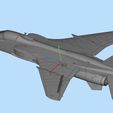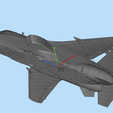At the beginning of World War I, France took the lead in putting ground machine guns on planes for air combat, and then specialized fighter planes appeared. During this period, the fighter jets were mostly of double winged wooden structure, using piston engines and mainly equipped with machine guns.
Before World War II, the structure of the fighter developed into a single wing all metal structure, with machine guns or Aircraft artillery mounted on the aircraft and radio communication equipment installed inside. During the World War II, the flight speed of the piston fighter was 750 km/h, with a ceiling of 12000 meters. Famous fighter jets include the P-51 from the United States, the Spitfire from the UK, the Ra-7 from the Soviet Union, the Fw.190 from Germany, and the Zero from Japan. At the end of World War II, jet fighters, such as Germany's Me-262, were put into use, with a speed of about 900 km/h.
In the early 1950s, jet fighters had basically replaced piston fighters. By the 1960s, the maximum speed of jet fighters was around M2.0, with a practical ceiling of nearly 20000 meters, and they began to be equipped with air to air missiles, with onboard equipment becoming increasingly sophisticated. Famous fighter jets include the F-104 and F-4 from the United States, the MiG-21 and MiG-23 from the Soviet Union, and the Mirage III from France. In the 1970s, based on the experience of multiple local wars, a group of fighter jets with good maneuverability and strong combat ability were developed, such as the F-15 and F-16 of the United States, the Mirage 2000 of France, and the MiG-29 and Su-27 of the Soviet Union. These planes have been heavily equipped with troops. After the 1980s, new fighter jets have been tested or equipped with "Typhoon" jointly developed by the UK, Germany, Italy, and Spain, "Rafale" in France, JAS.39 "Gripen" in Sweden, Su-37 in Russia, and F/A-22, F-35 in the United States. The common characteristics of this type of fighter jet are its novel layout, engine thrust exceeding the aircraft weight, relaxed static stability, strong firepower and maneuverability, short takeoff, landing, and running distance, and the F/A-22 also has stealth characteristics and the ability to cruise at supersonic speeds without the use of afterburner.
China established an aviation industry in the mid-1950s to produce fighter jets. In July 1956, the J-5 fighter plane successfully flew. In 1958, the J-6 fighter plane made its first test flight. In 1966, production of the J-7 fighter began. In July 1969, the J-8 fighter plane made its first test flight. The J-8 II all-weather fighter developed on the basis of the J-8 was successfully tested in June 1984. In the 1990s, a new generation of fighter jets was successfully developed. All these planes were successively put into production and equipped with troops. In the 1950s and 1960s, some countries referred to fighter jets equipped with radar and suitable for all-weather operations, mainly used to intercept enemy aircraft, as interceptors. Interceptors at that time rose faster than ordinary fighters, with good growth performance and large Radius of action, but poor combat ability. Since modern fighters are basically equipped with radars and have a large Radius of action, they can complete the task of interceptors. After the 1970s, other countries except the Soviet Union no longer developed specialized interceptors. At the beginning of the 21st century, Russia still maintained and developed its original MiG-25 and MiG-31 interceptors.












